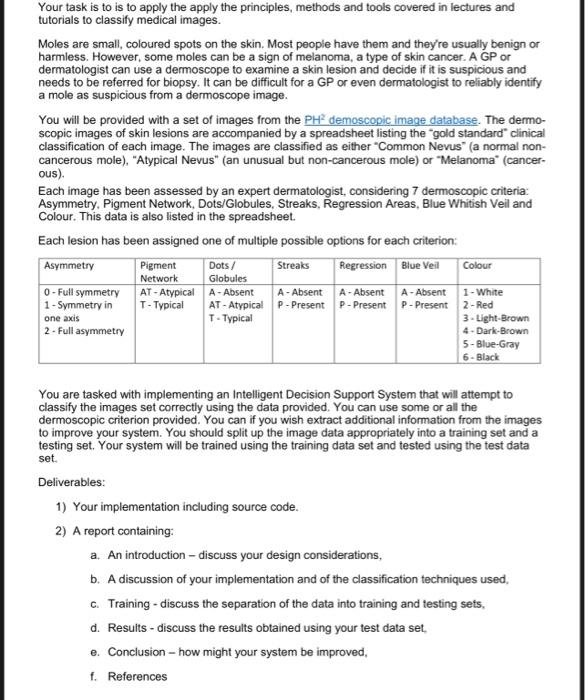Your task is to is to apply the apply the principles, methods and tools covered in lectures and tutorials to classify medical images. Moles are small, coloured spots on the skin. Most people have them and they're usually benign or harmless. However, some moles can be a sign of melanoma, a type of skin cancer. A GP or dermatologist can use a dermoscope to examine a skin lesion and decide if it is suspicious and needs to be referred for biopsy. It can be difficult for a GP or even dermatologist to reliably identify a mole as suspicious from a dermoscope image. You will be provided with a set of images from the PH2 demoscopic image database. The dermoscopic images of skin lesions are accompanied by a spreadsheet listing the "gold standard" clinical classification of each image. The images are classified as either "Common Nevus" (a normal noncancerous mole), "Atypical Nevus" (an unusual but non-cancerous mole) or "Melanoma" (cancerous). Each image has been assessed by an expert dermatologist, considering 7 dermoscopic criteria: Asymmetry. Pigment Network, Dots/Globules, Streaks, Regression Areas, Blue Whitish Veil and Colour. This data is also listed in the spreadsheet. Each lesion has been assigned one of multiple possible options for each criterion: You are tasked with implementing an Intelligent Decision Support System that will attempt to classify the images set correctly using the data provided. You can use some or all the dermoscopic criterion provided. You can if you wish extract additional information from the images to improve your system. You should split up the image data appropriately into a training set and a testing set. Your system will be trained using the training data set and tested using the test data set. Deliverables: 1) Your implementation including source code. 2) A report containing: a. An introduction - discuss your design considerations, b. A discussion of your implementation and of the classification techniques used. c. Training - discuss the separation of the data into training and testing sets, d. Results - discuss the results obtained using your test data set, e. Conclusion - how might your system be improved, f. References







